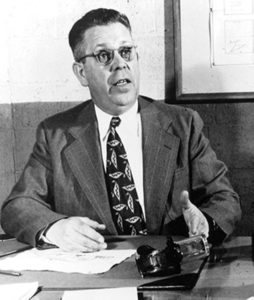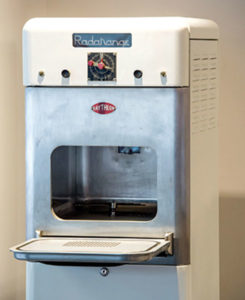By Brett Peruzzi, Contributing Writer
Waltham – Like many inventions, the technology that would lead to the microwave oven was discovered by accident, in a Massachusetts laboratory.

In 1945, a Raytheon engineer named Percy Spencer was testing magnetrons, a type of vacuum tube that generates microwaves and is used in radar systems, when he noticed that a candy bar in his pocket had started to grow warm and melt. Intrigued, he returned to the lab in Waltham the next day with some popping corn, and the kernels began popping when he fired up the vacuum tubes. He next fashioned a crude oven by installing a magnetron inside a metal box and used it to reheat his lunches. Spencer and Raytheon, today a global defense industry giant, patented the technology that allowed food to be cooked faster than ever.
The first microwave – the RadaRange
Two years later Raytheon released its first commercial microwave oven, which it dubbed the RadaRange. It wasn’t an immediate success, however, since it was nearly six feet tall, weighed almost 750 pounds, and cost $5,000, over $58,000 in today’s dollars. Laurence Marshall, one of the founders of Raytheon who also served as president and chairman of the board of directors, used one of the original RadaRange microwave ovens in his home for decades before donating it to the company archives. For the general public, the microwave oven was a marvel.

“One area resident recalls,” notes the book Raytheon Company: The First Sixty Years, “that a Raytheon RadaRange held crowds spellbound at the now defunct Norumbega Park in Newton with its ability to convert cellophane bags of corn into popped corn in a matter of seconds.”
Over the years, the size of commercial microwave ovens shrunk dramatically until they fit on a counter top or could be easily installed under a kitchen cabinet. Prices dropped steeply as well, putting them within easy reach of most middle-class households. By the mid-1970s microwaves were outselling gas ranges, and a decade later one in four American households had one. Today there’s a microwave oven in over 90% of American households, which many people use every day to both cook and reheat a wide variety of food and beverages, and they probably can’t imagine life without it.
An unlikely inventor
Spencer was an unlikely candidate to become a famed inventor, who by the time of his retirement, held about 300 patents. He grew up poor in Maine and did not even complete grammar school. After joining the Navy at age 18, he became an expert in radio technology, largely through self-study, and then went on to teach himself higher mathematics like calculus and trigonometry, and scientific subjects such as chemistry and physics. He was an early Raytheon employee, joining the company in the 1920s, and eventually became a senior vice president and member of the board of directors, managing thousands of employees. Today, there is a building named in his honor at the Raytheon Missile Defense Center in Woburn, and one of the early RadaRange microwaves is on display in the lobby.
And what did Spencer earn for his revolutionary discovery? The standard Raytheon payment at the time for all of its inventors – a token $2 bonus, worth just under $29 today.
Photos/submitted












